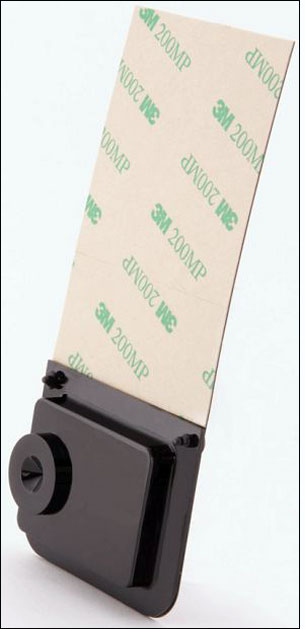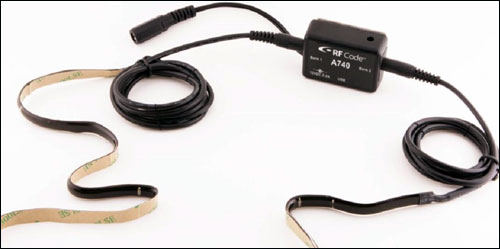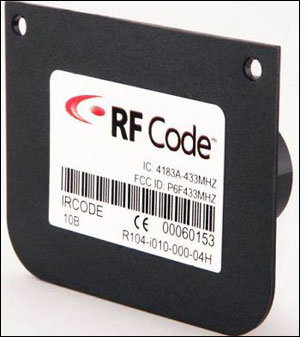A new solution combining infrared (IR) beacons and active RFID tags promises to provide data centers with a tracking system enabling them to determine the locations (and, in some cases, the conditions) of their IT assets at a fraction of the cost of existing active RFID solutions, according to solutions developer RF Code. The system, the company reports, is currently being beta-tested by two unnamed computer firms that represent two of the largest server manufacturers worldwide—both located in Austin, Texas.
The system, made available today, uses hybrid technology similar to what RF Code already provides to GE Healthcare—which, according to Mitch Medford, the company’s CEO, has made RF Code a substantial supplier of real-time location systems (RTLS) involving active RFID tags to the health-care industry. In this case, the solution employs the same technology found in the health-care solution, making it cheaper and easier for data centers to track their assets’ locations and environmental status. It does this by means of active RFID tags to identify each individual server, and IR beacons to identify the specific rack in which a particular server has been installed.

In 2008, RF Code began providing an RFID-only solution for data centers (see RF Code Announces Platform for Tracking IT Assets). The market has been changing, however, with more servers being stored in open racks (instead of enclosed cabinets), and RF Code sought to develop a system that addressed several shortcomings of the previous system. That prior system called for an RFID reader to be installed on every rack, receiving data from an RF Code 433 MHz active RFID tag attached to each server, and transmitting that information to RF Code’s Zone Manager middleware, which then interpreted the server’s location in real time.
The system worked, says Chris Gaskins, the company’s VP of product development, but it was expensive for users to purchase a separate $600 reader for every rack. Moreover, each reader required the space of one server, thereby reducing the number of servers per rack that a data center could store. In addition, in an effort to reduce power consumption, most data centers are now shifting to open racks, which allow cooled air to circulate across the servers more efficiently. With open racks, however, the RFID readers would receive transmissions from tags on neighboring racks, making location data less accurate. “We realized we had to go do something else,” Gaskins says.
The resulting patented solution combines radio frequency identification to identify each individual server, and infrared beacons to inform an RFID tag of its location. As a result, an installation could be accomplished with just one or two readers in the entire center, as well as a much smaller and less expensive IR beacon attached to each rack, and the system could be installed by the data center’s management itself.
With the new solution, every server in each rack is fitted with an adhesive-backed RF Code asset tag—either the R104 or R114 model, depending on mounting requirements. Infrared beacons known as A740 control boxes are mounted inside each rack, and two 90-inch-long IR light strips with adhesives backs are attached to the left and right sides of the rack, extending from top to bottom. The strips plug directly into the control box. Via the light strips, the A740 transmits an IR signal, encoded with a unique ID number, and the tags in that rack receive the IR signal emitted by the surrounding light strips.
Every 10 seconds, each tag transmits its own ID number, as well as the ID of its rack’s control box, to an RF Code M200 reader, installed in the data center’s ceiling. In that way, without the need for triangulation or multiple readers, the server’s location data (based on the ID number of the particular rack in which it was installed) can then be sent back to the server via a cabled connection. RF Code software can sit on the back-end system, either as a stand-alone system or integrated into the data center’s own management software.
The readers can cover an area of 2,000 to 5,000 square feet, depending on the height of the racks, as well as that of the ceiling. If the tag has a temperature or humidity sensor built into it, this information is also transmitted to the interrogator.
The IR/RFID tags can receive IR data from the light strips only if they are located within five to six inches of those strips. In that way, if they are removed from the rack, the system fails to receive a transmission and is immediately alerted that something has been taken. The short range of the IR signal ensures that no stray data from other IR light strips on other racks is received by tags in the data center.
The A740 control box can be powered by a mini USB port, or via a standard power connection.
The system’s cost is approximately one-third the typical expense of an installation using only active RFID tags and readers, Gaskins says. The A740 IR control box with two light strips costs $199, each R104 or R114 tag is priced at $19.95 and the interrogator’s price tag is $1,249. In a typical data center with 100 racks, he says, the entire installation would cost about $23,647, or $236.47 per rack.
“We’re really excited about this solution,” Gaskins states. “It’s designed to be customer-installable”—which, he notes, is an advantage to many data-center managers who have security constraints regarding which personnel can work around the servers. Those still utilizing the older RF Code RFID-only solution can continue using that system, or they could upgrade to the IR/RFID version without making any changes to the existing Zone Manager middleware. “We expect that many will want to switch over,” he says, especially as more data centers evolve to open racks.



